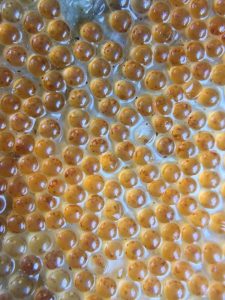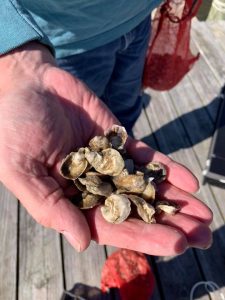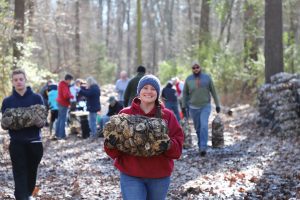“O Oysters, come and walk with us!” The Walrus did beseech. “A pleasant walk, a pleasant talk, along the briny beach….”
Yes, as the Walrus knew, oysters are delicious, but they also are vital to the health of the Chesapeake Bay and its contributing waterways. Think of them as stationary Roombas for the sediment in the waters, filtering it out as they extract nutrients. They make our waters cleaner, serve as food source for otters, herons and other species, provide economic benefits via oyster fishermen, and are awfully tasty with a squeeze of lemon or hot sauce.
Thanks to the Riverines’ heralded (and award winning) oyster shell recycling project, the oyster population is healthier than it has been in many years. Working with the Virginia Oyster Shell Recycling Program (VOSRP), a part of VCU Rice Rivers Center, our volunteers have helped to collect many tons of shell and planted millions of spat on shell oysters on Virginia reefs. Cindy Andrews, program coordinator for the Richmond area said, “ we absolutely could not do this important restoration work without the volunteers from the Riverine chapter and other chapters around the state. They are the backbone of our success.”
“Don’t chuck that shuck!” is their motto, as they have established partnerships with seafood restaurants throughout the area where the Riverines come weekly (or biweekly) to pick up the restaurants’ oyster shells and take them to a central “holding facility” (a fancy way to say dumpsters).
For some of the dedicated Riverine oyster team, this ferrying of shells from restaurant to the dumpster is their major involvement in the project. Other Riverines get involved in the next step – once the dumpsters are full, the shells are taken to the VCU Rice Rivers Center where our folks and members of the public assemble mesh bags, and fill them shells. The bags are eventually loaded onto a flatbed and transported to one of the program partners, Island Seafood, on Gwynn’s Island.
Those interested in a little water adventure can sign up for the next step: ferrying the oysters out to the designated reefs in the waterways and dumping them in so they can build up the oyster reef and serve as nurseries for the next generation of oysters. Currently, the project works on sanctuary reefs in the Piankatank River.


